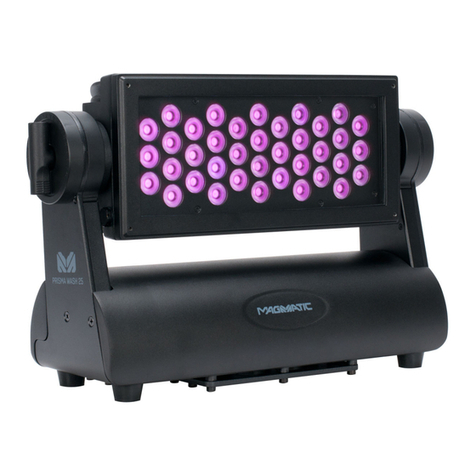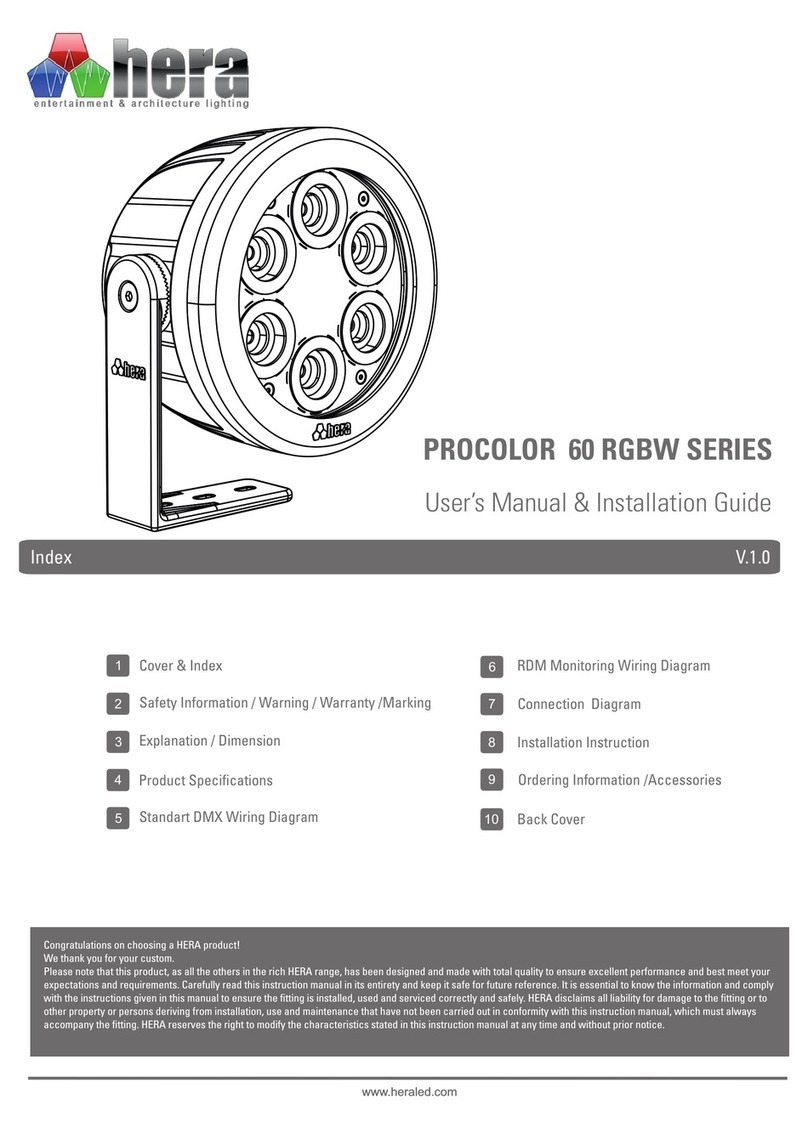Strong SEL10 User manual

SEL10
Lamphead & Base Assembly
Operator’s Manual & Parts List
for Equipment Type MLS210
Rev. October 17, 2000
a division of Ballantyne of Omaha, Inc.
4350 McKinley Street • Omaha, Nebraska 68112 USA
Tel 402/453-4444 • Fax 402/453-7238

Lamphead Housing
Front Cowl Assembly This Bolt Installed for
SHIPPING ONLY.
Clamping Knob,
Projection Angle
Remove Bolt after transport-
ing Lamphead. Set Projection
Angle and secure tilt angle
using Clamping Knob.
Locking Mechanism,
Horizontal Pan
Ventilation Opening
(Do Not Obstruct)
Cover Plate,
Control Panel
Yoke Assembly
Base & Power
Supply Housing
Power Input Jacks
SEL10 LAMPHEAD & BASE ASSEMBLY
Secured for Transport
Hoisting Bracket
(1 of 4)

PREFACE
The SEL10 is a 10,000 watt xenon searchlight mounted on a rotating base. The angle and
direction of light projection are independently adjustable through a 360° arc in either direction, and
lock manually in the desired position. The unit is mounted on a trailer and powered by a diesel engine-
generator unit.
Continuous high output performance is assured by means of a coated, 30 inch precision
electroformed, parabolic nickel reflector. The reflector is carefully positioned at the factory and re-
quires no operator adjustment. The light source is a 10,000 watt xenon bulb which can operate in any
position (vertical to horizontal) and maintains a constant color temperature of 5600° Kelvin. A
squirrelcage blower is mounted in the lamphead to provide continuous forced-air cooling while the
bulb is in operation. The bulb is warranted for 500 hours.
Operator controls mounted to the instrument panel include a LAMP ON/OFF switch and a
FOCUS switch. An AC motor inside the lamphead moves the bulb inside the reflector to adjust focus.
An hour meter, located adjacent to the switches, records the elapsed time of xenon bulb operation.
Direct current for the xenon bulb is derived from two high reactance xenon power supplies
mounted in the base of the unit. All models are designed for 50/60 Hertz operation, and are available
in varying AC input types, depending upon the confuguration of the main power transformer. Check
the Equipment Data Plate to determine the exact AC requirement prior to installation.
Coarse and fine taps are easily set to regulate the DC currnt to the xenon lamphead. Some
models of these power supplies have the capability of overdriving the xenon bulb; carefully check the
power requirements specified by the bulb manufacturer and do not exceed the maximum current stated.
The two power supplies, wired in parallel, produce the high open circuit ( “no load”) voltage
required for bulb ignition, and, after ignition, the filtered low voltage current to sustain operation. The
bridge rectifiers utilize silicon diodes as the power conversion elements. The diodes are mounted to
oversize heat sinks to disperse the heat generated by normal operatrion. Internally wired squirrelcage
blowers provide additional forced-air cooling of each power supply. Thermal switches act as safety
interlocks to shut down the power supplies and protect the rectifier diodes in case temperatures reach
excessive levels.
INSTALLATION
Check the equipment Data Plate and make certain that the AC source conforms to the power
requirements of the main transformer. The AC service wiring should be installed by a licensed electri-
cian in conformance to local codes. The unit must be connected to an adequate earth ground.
The AC line to the xenon power supply must include a marked line safety switch or other power
disconnect device adjacent to the unit and accessible to the operator. For operator safety, it is
necessary to turn off all power to the unit when adjusting or servicing the xenon power supply. This safety
switch or power disconnect should be tagged “OFF - UNIT UNDER REPAIR” when the power supply is
being serviced.
On trailer-mounted units, connect the (3) phase leads and the (1) ground lead from the genera-
tor unit to the color-coded power inlet jacks near the bottom of the base cabinet. Set generator output
to 208/230 V.AC, 60 Hz.
Observing all safety procedures, install a 10,000 watt xenon bulb into the lamphead. Check the
bulb manufacturer’s documentation to determine the recommended current range of the bulb. Most
10 kW xenon bulbs operate between 180 to 220 amperes DC at 45 to 55 volts DC. A new bulb is normally
first operated at “nominal” current, which is around 85% of the maximum level (190 A.). DO NOT, at any
time, exceed the maximum current level (220 A.) specified by the bulb manufacturer.
1

Remove a side panel from the base assembly to gain access to the bridge rectifier of one of the
xenon power supplies. Use either the positive (red) or negative (black) lead at the top of the rectifier heat
sink as a connection point for the clamp-on ammeter. Voltage measurements can be taken at the hex
head screws connecting the red (+) and black (-) leads to their respective heat sinks.
Observe all due
safety precautions when taking voltage and current readings in a power “ON”condition.
INSTALLATION (continued)
OPERATOR’S CONTROL PANEL
Indicator Lights,
Phase Detection
Circuit Breaker, Auxilliary Power
Toggle Switch, POWER ON-OFF
Elapsed Time Meter
(HOURS)
Pushbutton Switch,
IGNITE
Toggle Switch,
FOCUS IN-OUT
2

INSTRUCTIONS FOR REMOVING AND INSTALLING A TYPE “THS” XENON BULB
IN A SEL10 FIXTURE
NOTE
FAMILIARIZE YOURSELF WITH THE LOCATION AND IDENTIFICATION
OF THE COMPONENTS OF THIS SYSTEM AND ALSO THE NORMAL
OPERATION OF THE SYSTEM BEFORE ATTEMPTING ANY ADJUSTMENT
OR SERVICE.
NOTE
COMPLETELY READ THROUGH AND HAVE A GOOD UNDERSTANDING OF THE
PROCEDURES BEFORE ATTEMPTING TO SERVICE THIS SYSTEM. FAILURE TO
DO SO MAY RESULT IN FATAL INJURY OR EQUIPMENT DAMAGE.
NOTE
THE LAMPHEAD SHOULD BE LOCKED IN THE HORIZONTAL POSITION
DURING ANY SERVICE PROCEDURES.
WARNING
DISCONNECT POWER SOURCE BEFORE SERVICING THIS EQUIPMENT.
WARNING
A PROTECTIVE JACKET, FULL FACE SHIELD, AND PROTECTIVE GLOVES MUST
BE WORN AT ALL TIMES WHEN THE LAMP HEAD IS OPENED WITH A BULB
INSTALLED OR WHEN HANDLING THE XENON BULBS. SERIOUS INJURY MAY
OCCUR IF PROPER SAFETY PRECAUTIONS ARE NOT OBSERVED.
READ ALL ENCLOSED INSTRUCTIONS AND INFORMATION SHEETS BEFORE
HANDLING THE BULB.
WARNING
NEVER OPERATE A FIXTURE WITH AN EXPOSED BULB! THERE IS AN EXTREME
DANGER OF SEVERE BURNS TO EXPOSED SKIN AND EYES FROM THE
ULTRAVIOLET LIGHT EMITTED FROM THE EXPOSED BULB. DAMAGE CAN
OCCUR IN AS LITTLE AS 30 SECONDS OF EXPOSURE. THERE IS ALSO
AN ADDITIONAL DANGER FROM FLYING QUARTZ IF AN
EXPOSED BULB EXPLODES!
EQUIPMENT REQUIRED
1. PROTECTIVE SAFETY EQUIPMENT KIT
2. 7/16" END WRENCH OR SOCKET
3. ALLEN WRENCH 5/32"
3
Other manuals for SEL10
1
Other Strong Dj Equipment manuals


















